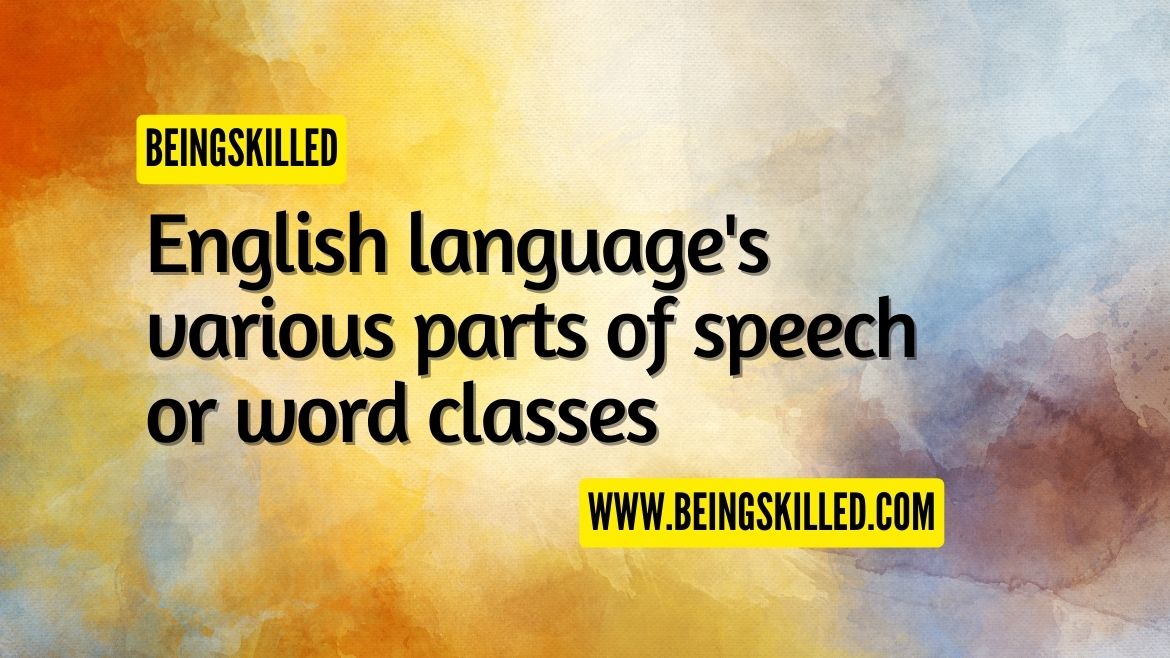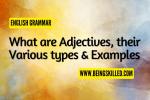On the basis of grammatical behavior the words of a language are divided into several classes called parts of speech or word classes. The English language has nine parts of speech or word classes, namely: Adjectives, Conjunctions, Verbs, Adverbs, Nouns, Pronouns, Preposition, Determiners and Interjections. These are the building blocks of the grammar.
As each word plays a different role in the sentence, therefore the part of speech indicates what each word functions in meaning and grammatically in a sentence -- meaning how the word is used in the sentence.
There are sentences in which each word can play role of multiple parts of speech. The parts of speech must be understood well to determine the correct definition of of any word.
It's important to observe the different components of a sentence and to be able to identify them. That helps in understanding how different words together take a form of a sentence that conveys the desired meaning or information.
Below are the nine parts of speech in English language:
Noun - A noun is name of a person, thing, place, etc. A noun is a word for person, thing, place, objects, nature, etc which are usually accompanied by an article. Large no. of words are used as names.
There are proper nouns and common nouns. Proper nouns always have their starting character capital which isn't the case with common nouns.
A noun acts as a subject or object of a verb.
Different types of noun are - Proper, Common, abstract, concrete, countable, uncountable, singular, plural, collective, compound and possessive nouns.
Examples of noun are - Paris, Apple, John, etc.
Some examples of sentences using Nouns are -
- Eiffel tower is in Paris.
- The table has an Apple on it.
Pronouns - A pronoun is a word that replaces a noun or points to a noun when replaced. A pronoun is a word used in place of specific noun called antecedent.
Pronouns help us in preventing the repetitive use of noun which can get lenthy and annoying for the reader.
There are various types of pronouns namely Personal pronouns, Possessive pronouns, Definitepronouns, Indefinite pronouns, Relative pronouns, Demonstrative pronouns, Reciprocal pronouns, Reflexive pronouns and Interrogative pronouns.
Some examples of sentences using Pronouns are - I, he, she, they, them, their, whose, who, which, that, you, we, it.
Example sentences using Pronoun are -
- When is she going to movies?
- He found the job by himself.
Verbs - A verb is a word that expresses an action performed by animal, person or a place. An activity that can refer to anything that happens or a state of being. Verbs follow the noun. Verbs change to convey tense, aspect, mood, voice, person, gender, object, or subject.
Different types of verbs are - Transitive, Intransitive and linking.
Some examples of verb are - go, jump, write, exist, ride, cry, laugh, etc.
Example sentences using Verb are -
- She dances.
- He peddled fast to finish first.
- He jumped from the wall.
- He can draw.
- He is 25 years old.
Adverbs - Adverb is a word that explains a verb further. Adverb gives more information about the verb, explaining how the action was done in the forms how, why, where, when, etc. Adverb describes a verb, adjective or other adverbs but never nouns.
Adverb can be located at the beginning or end of the sentence, before or after the verb. Adverbs tend to end with -ly.
Some examples of Adverb are - never, there, slowly, completely, rather, very, quickly.
Example sentences using Adverb are -
- She was running fast.
- She laughed loudly.
Adjectives - Adjectives gives more information about the noun or pronoun, or we can say an adjective modifies/ describes/ specifies a noun or a pronoun. Articles (the, an, the) are usually classified as adjectives.
Some examples of Adjectives are: good, beautiful, long, short, nice, sweet, etc, old, new, silly, smart.
Example sentences using Adjectives are -
- He's a very intelligent student.
- The cricket player is very young.
Preposition - Preposition is a word that shows the relationship between a noun or pronoun with other words in a sentence. A preposition is placed before a noun or noun phrase or pronoun in order to form a phrase that modifies another word in the sentence. Prepositions are always part of prepositional phrases which functions an adjective or an adverb. They often show where the different things are located or positioned.
It could be single word (Simple) or may have multiple words (Complex / compound).
Some examples of Preposition are - above, into, with, by, about.
Example sentences using Preposition are -
- He left the cookies on top of the table.
- The hospital is across the highway.
- The coins are in the pocket.
Interjections - An Injerjection expresses (strong) emotion and convey reactions. Interjections are usually followed by an exclamation mark. Injections can form a complete sentence on their own as well as they can be contained within sentences.
Some examples of Injerjection are - Ouch, Oops, Ah!, wow!, aha!
Example sentences using Interjection are -
- Bravo! You did it.
Conjunctions - Conjunction is a word that connects two words, ideas, clauses or phrases together in a sentence and demonstrates that they are connected.
Types of conjunctions are - Coordinating and subordinating conjunctions.
Coordinating conjunctions connect or link words or groups of words having equal significance in a sentence i.. each part of the sentence can stand on their own as complete sentences.
Subordinating conjunctions are use to connect clauses that are not the same or equal or considered less important, such as - although, while, because, however, that, as before, since
Some examples of conjuctions are: and, since, if, unless, yet, so, for, but, nor, because, when, after
Example sentences using Conjunction are -
- The Uber left because they got late.
- Arjun likes both Pasta and Pizza.
- I went to party after studying for couple of hours.
Articles/ Determiners - These are type of adjectives and are used to describe a common noun. Determiners are essential for proper syntax as opposed to adjectives. Articles allow to signify if the object is is specific "the" or if it isn't specific ("a,"an"). These are words that were once classified as Adjective. New grammar rule classifies Articles as determiners.
Two types of articles are - definite - points to specific thing "the" and indefinite - refers to not specific thing.
Examples of determiners are - a, an, the, these, this, that, enough, few, much, which
Example sentences using Articles are -
- I would like an Apple. (Not specific - any apple)
- Go get the lunchbox. (Specific lunchbox)
In the English Grammar quizzes we will learn how to identify the various parts of speech in a sentence. To know what part of speec a word falls into, look not only at the word but also at its meaning, position and use in a sentence.
Some easy tricks are:
- If a word is an adjective and ends with "-ly", it is an adverb. For example - swiftly, rapidly, etc.
- If you can replace a word with a noun and it still conveys the same meaning, it is a pronoun. As pronouns replace a noun.
Read quickly about English Parts of Speech here.







